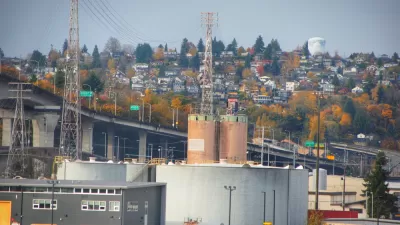John Schwartz reports on a bridge replacement technique that demonstrates innovation in construction, as well as customer service.
The Massachusetts Department of Transportation has recently shifted their approach to highway projects. Administrator, Frank DePaola, describes how the department has been so narrowly focused on construction and road projects that they've lost sight of the fact that they work for the local drivers, not the contractors.
Gov. Deval Patrick points out, ""It's their money, after all. And it's their broken bridge."
Massachusetts is leading the charge with an innovative bridge replacement technique meant to alleviate the inconvenience to drivers when projects drag on for years. "Accelerated bridge construction" is being employed across the state to build and replace critical infrastructure as quickly as possible, sometimes as quick as a weekend.
NYT reportor John Schwartz observed the completion of Boston's River Street Bridge. Using the new accelerated technique, workers began constructing the superstructure a year ago on an adjacent lot. Upon completion, the old bridge was deconstructed, precast concrete caps were placed on the existing bridge abutments and the new bridge was slipped in "like the world's biggest Lego block."
While Massachusetts is leading the way, accelerated bridge construction is picking up steam across the country. San Francisco's Golden Gate Bridge is getting a prefabricated makeover one section at a time so as to avoid full road closure. The new technique is not only faster and avoids lengthy traffic detours, but it also tends to cost about the same or less as traditional bridge replacement projects.
Thanks to Jessica Brent
FULL STORY: Did Someone Order an Instant Bridge?

Maui's Vacation Rental Debate Turns Ugly
Verbal attacks, misinformation campaigns and fistfights plague a high-stakes debate to convert thousands of vacation rentals into long-term housing.

Planetizen Federal Action Tracker
A weekly monitor of how Trump’s orders and actions are impacting planners and planning in America.

In Urban Planning, AI Prompting Could be the New Design Thinking
Creativity has long been key to great urban design. What if we see AI as our new creative partner?

King County Supportive Housing Program Offers Hope for Unhoused Residents
The county is taking a ‘Housing First’ approach that prioritizes getting people into housing, then offering wraparound supportive services.

Researchers Use AI to Get Clearer Picture of US Housing
Analysts are using artificial intelligence to supercharge their research by allowing them to comb through data faster. Though these AI tools can be error prone, they save time and housing researchers are optimistic about the future.

Making Shared Micromobility More Inclusive
Cities and shared mobility system operators can do more to include people with disabilities in planning and operations, per a new report.
Urban Design for Planners 1: Software Tools
This six-course series explores essential urban design concepts using open source software and equips planners with the tools they need to participate fully in the urban design process.
Planning for Universal Design
Learn the tools for implementing Universal Design in planning regulations.
planning NEXT
Appalachian Highlands Housing Partners
Mpact (founded as Rail~Volution)
City of Camden Redevelopment Agency
City of Astoria
City of Portland
City of Laramie





























